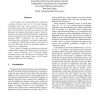Free Online Productivity Tools
i2Speak
i2Symbol
i2OCR
iTex2Img
iWeb2Print
iWeb2Shot
i2Type
iPdf2Split
iPdf2Merge
i2Bopomofo
i2Arabic
i2Style
i2Image
i2PDF
iLatex2Rtf
Sci2ools
106
click to vote
EUROMICRO
1998
IEEE
1998
IEEE
The Latency Hiding Effectiveness of Decoupled Access/Execute Processors
Several studies have demonstrated that out-of-order execution processors may not be the most adequate organization for wide issue processors due to the increasing penalties that wire delays will cause in the issue logic. The main target of out-of-order execution is to hide functional unit latencies and memory latency. However, the former can be quite effectively handled at compile time and this observation is one of the main arguments for the emerging EPIC architectures. In this paper, we demonstrate that a decoupled access/execute organization is very effective at hiding memory latency, even when it is very long. This paper presents a thorough evaluation of such processor organization. First, a generic decoupled access/execute architecture is defined and evaluated. Then the benefits of a lockup-free cache, control speculation and a store-load bypass mechanism under such architecture are evaluated. Our analysis indicates that memory latency can be almost completely hidden by such tech...
EUROMICRO 1998 | Memory Latency | Out-of-order Execution | Out-of-order Execution Processors | Software Engineering |
Related Content
| Added | 04 Aug 2010 |
| Updated | 04 Aug 2010 |
| Type | Conference |
| Year | 1998 |
| Where | EUROMICRO |
| Authors | Joan-Manuel Parcerisa, Antonio González |
Comments (0)

